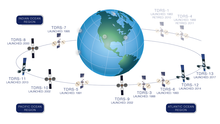TDRS-7, known before launch as TDRS-G, is an American communications satellite, of first generation, which is operated by NASA as part of the Tracking and Data Relay Satellite System. It was constructed by TRW as a replacement for TDRS-B, which had been lost in the Challenger accident, and was the last first generation TDRS satellite to be launched.
History
TDRS-7 is based on a custom satellite bus which was used for all seven first generation TDRS satellites.[3] Whilst similar to its predecessors, it differed from them slightly in that twelve G/H band (C band (IEEE)) transponders which had been included on the previous satellites were omitted.[4] It was the last communications satellite, other than amateur radio spacecraft, to be deployed by a Space Shuttle.
Launch

The TDRS-G satellite was deployed from Space Shuttle Discovery during the STS-70 mission in 1995. Discovery was launched from Kennedy Space Center Launch Complex 39B at 13:41:55 UTC on 13 July 1995.[5] TDRS-G was deployed from Discovery around six hours after launch, and was raised to geosynchronous orbit by means of an Inertial Upper Stage.[5]
Deployment
The twin-stage solid-propellent Inertial Upper Stage made two burns. The first stage burn occurred around an hour after deployment from Discovery, and placed the satellite into a geosynchronous transfer orbit. At 02:30 UTC on 14 July 1995 it reached apogee, and the second stage fired, placing TDRS-G into geostationary orbit.[6] At this point, it received its operational designation, TDRS-7. It was placed at a longitude 150.0° West of the Greenwich Meridian, where it underwent on-orbit testing. In May 1996, it was moved to 171.0° West where it was stored as an in-orbit spare, and subsequently entered service.[7] In December 2003, it was relocated to 150.5° West.[8] It arrived the next month, and was returned to storage as a reserve satellite.


See also
References
- ^ "UCS Satellite Database". Union of Concerned Scientists. 1 July 2009. Retrieved 9 August 2009.
- ^ "NASA – NSSDCA – Spacecraft – Trajectory Details". nssdc.gsfc.nasa.gov. Retrieved 2 May 2018.
 This article incorporates text from this source, which is in the public domain.
This article incorporates text from this source, which is in the public domain.
- ^ Krebs, Gunter. "TDRS 1, 2, 3, 4, 5, 6". Gunter's Space Page. Retrieved 9 August 2009.
- ^ Krebs, Gunter. "TDRS 7". Gunter's Space Page. Retrieved 9 August 2009.
- ^ a b McDowell, Jonathan. "Launch Log". Jonathan's Space Page. Retrieved 9 August 2009.
- ^ McDowell, Jonathan. "Index". Geostationary Orbit Catalog. Jonathan's Space Page. Archived from the original on 6 April 2010. Retrieved 9 August 2009.
- ^ "The TDRS-J satellite". Spaceflight Now. 1 December 2002. Retrieved 9 August 2009.
- ^ "TDRS 7". TSE. Retrieved 9 August 2009.










You must be logged in to post a comment.